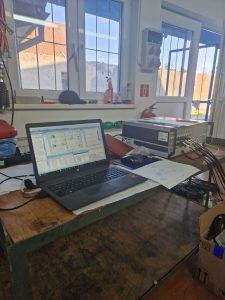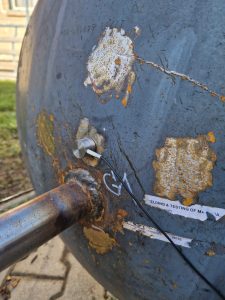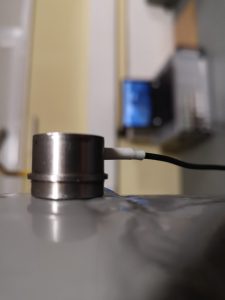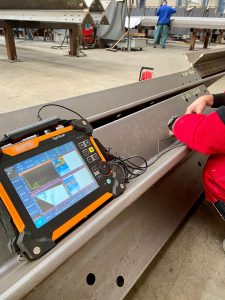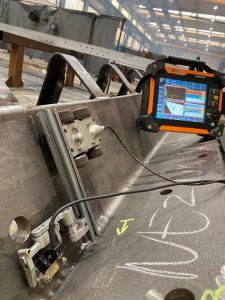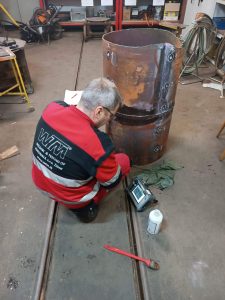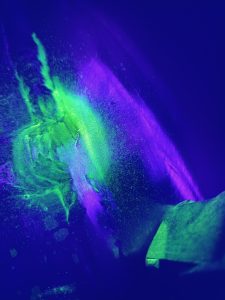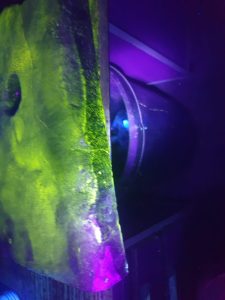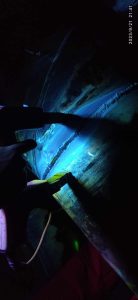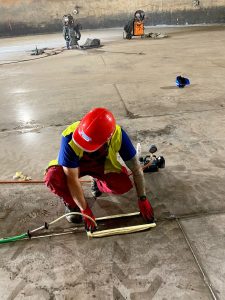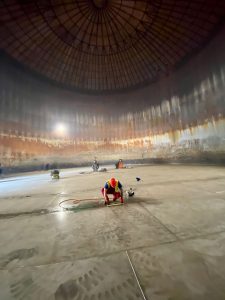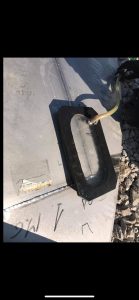Non-destructive inspection makes it possible to identify and document material inconsistencies using physical phenomena. For the needs of our customers we can provide:
- Material Testing
- Consultancy in designing NDT control
Types of tests:
- Radiation test ( RT )
- Ultrasonic Test ( UT )
- Visual test ( VT )
- Penetration / Capillary Test ( PT )
- Magnetic powder test ( MT )
- Leak test ( LT )
- Eddy current test ( ET )
- Sound emission (AT) test
We have qualified personnel according to STN EN ISO 9712 and SNTC-TC-1A, Level II and III.
Radiation test – RT
Radiography is the most commonly known test non-destructive method for obtaining a permanent picture of superficial and subsurface (internal) discontinuities. The same discontinuities can be checked repeatedly, and radiograms can be compared with measuring the change in the size and shape of the defect over time. It inspects welded parts, castings, forgings, wall thickness measurement, corrosion mapping, detection of reinforcements in concrete slabs, measurement of volumetric density of materials, measurement of porosity in concrete, etc.
Conventional (image) radiography is the most sensitive test method, but digital (computer) radiography has many advantages over it, such as speed, ability to work with a wider range of thicknesses of radiated objects, exposure time and positive effect on the environment.
Our instrumentation:
- X-ray lamps
- Portable emitters based on Se75
- Portable emitters based on Ir192
- Portable emitters based on Yb169 (on request)
- Calling machines at all workplaces
- Two mobile laboratories
- Digital radiography
We perform radiation tests at an approved defectoscopic workplace at the company's headquarters and at temporary workplaces. At present, we have a valid license to perform radiation tests – RT at temporary workplaces in the Slovak and Czech Republics.
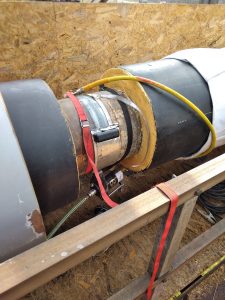
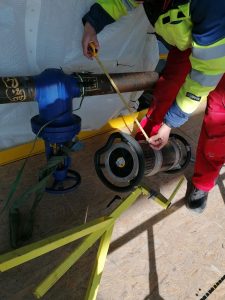
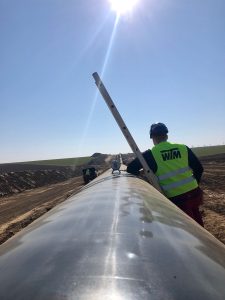
Ultrasonic Test – UT
In ultrasonic testing, very short pulse waves are sent into the material in order to identify internal defects or to determine the characteristics of the material. Commonly used this technique is also used when determining the thickness of materials, for example, checking the thickness of a material due to corrosion. Ultrasonic test is often used in the inspection of steel materials, alloys, it is also used in the inspection of concrete surfaces, wood, plastics and composites, although with much less accuracy. Typical applications are in the field of mechanical engineering, aviation and automotive.
There are two ways of receiving ultrasonic waves, reflection (pulsed echo) and attenuation. When reflected, the probe transmits and simultaneously receives a reflection. The reflection occurs on the other wall of the inspected object, or in a defect inside the material. The device displays this data in the form of a signal with an amplitude representing the time of arrival of the reflection. At attenuation, one probe sends a signal and the other senses the amount of signal that reaches it. Possible defects reduce the amount of transmitted waves and thus indicate the existence of defects in the object.
Our instrumentation:
- Olympus EPOCH 600
- Thickness gauges
- GE USM 60+
- Coating meters
- OMNISCAN MX (Phased Array)
We perform ultrasonic tests with modern devices, in addition to the classic ultrasound test, we also have a device for the PA method, which also allows visualization of the inspected object with recording, while also displaying the shape, depth and size of the defect found. Our advantage is also the readiness to perform tests in a very short time to meet even the demanding and strict requirements of our customers.
Visual inspection – VT
This is the oldest and most widely used non-destructive testing method. It applies to almost every product as an essential quality assurance tool. In general, the most unacceptable defects are defects on the surface of materials and products. Visual inspection, inspection and scanning can successfully detect these unacceptable surface discontinuities.
In addition to the usual direct visual inspection, we also offer an indirect method via videoscope. With this indirect method, we can check the internal spaces of welded structures with an endoscope.
With this device, we can also determine the size of welds in inaccessible areas. The test result can be stored and viewed in the form of video images.
We perform inspections in our permanent laboratory premises, but we also have a mobile laboratory. Our instrumentation and staff allow us to set up multiple working groups at the same time.


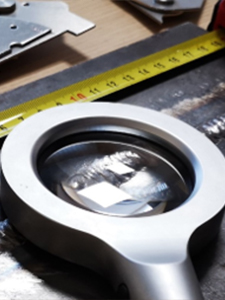
Penetration/Capillary Assay – PT
The penetration/capillary test is a fast, economical and widely used non-destructive test method for detecting surface defects in all types of non-porous materials (metals, plastics or ceramics). The penetration test is based on the principles of capillary action, in which the penetrant penetrates into the cavities on the surface of the tested object.
It is performed on a thoroughly cleaned test surface, by applying a colored or fluorescent penetrating liquid. After the specified time of action, the excess penetrant is removed and the developer is applied. After the developer dries, the penetrator penetrates the developer and thus draws an error. The test area is checked in natural light or black (UV) light (depending on the type of penetrant).
The test is used to inspect both metallic and non-metallic materials. The penetration test is mainly used on non-ferritic materials in the aerospace industry and in stainless steel products. The advantage of this test is cost and time saving. The disadvantage is that it reveals only superficial defects.

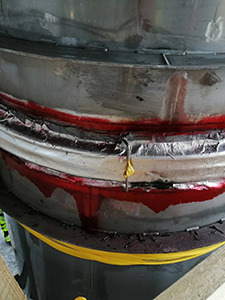
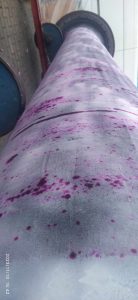
Magnetic powder test – MT
It is a non-destructive test method for detecting surface and subsurface inaccuracies in ferromagnetic materials. The test method involves applying a magnetic field externally, or applying an electric current directly through a material that creates a magnetic field in a material. At the same time, ferromagnetic particles deposited on the test surface are visible.
The presence of surface inconsistencies or inaccuracies just below the surface causes magnetic field deformation, which in turn causes magnetic scattering in an error. Magnetic particles are attracted by a scattered field in the area of discontinuity and adhere to the edges, where its shape is rendered. This test is a very sensitive test method. This method is not applicable to non-ferrous materials and austenitic stainless steels. There are several ways to magnetize the test parts.
Magnetization methods:
- Electromagnetic yoke, YOKE – Center conductor
- Auxiliary coil – Auxiliary conductor
- By the passage of electric current – a combination of the above
Our instrumentation:
- Manual magnetic yokes
- External sensors with current source
- Coils and auxiliary conductor with current source
When inspecting larger numbers of the same products, we manufacture our own equipment to inspect them to ensure the required magnetic field size, which will be able to identify defects in the required range for a particular product.
Leak test – LT – B, C
Detecting and eliminating leaks is important for the safety of equipment operation, for example in the chemical industry when working with toxic or flammable substances. Equally important is the protection of the environment, as well as the prevention of groundwater pollution from leaking reservoirs and cesspools. From a physical point of view, there is no absolutely tight wall. Each material is made up of a structure through which gas molecules can penetrate. By leak testing, we try to detect and determine the location of the leak with the greatest possible accuracy in the size of the leak. In most cases, the leakage of the device is manifested by a change in the pressure of the tested part.
The Sensistor H2000 hydrogen detector leak test presents several advantages compared to the Helium test. Sensistor H2000 allows you to detect leaks with a 5% hydrogen mixture of 95% nitrogen. This mixture is neither explosive nor flammable. When using the Helium test, the costs associated with performing the test itself are significantly increased.
Eddy current test – ET
Eddy current test – ET uses electromagnetic induction to detect deficiencies in conductive materials. The test object is affected by the alternating magnetic field of the coil, which induces alternating voltage in it. The conductive object represents a closed current conductor and therefore circular, so-called eddy currents, arise in it. Eddy currents create their own magnetic field, which has the opposite phase to the excitation field. This attenuates the excitation field and produces the resulting field given by the vector sum of both fields. Inconsistencies in the object reduce the electrical conductivity of the material and thus the density of eddy currents. The amplitude and phase of this resulting pole carry information about the state of the object. The change in eddy current flow and the corresponding change in phase and amplitude are compared with known values.
The eddy current test method can detect very small cracks in or near the surface of the material, the surfaces tested require minimal preparation. The biggest advantage of the eddy current method is that it can be used to determine surface defects on a varnished, insulated, or coated surface. Fault detection using this method is commonly used in aerospace, crane inspection, concrete industry and other industries where it is not possible to remove the protective surface.
Our instrumentation:
- GE Mentor EM
- Set of probes and gauges for surface inspection
- Set of probes and gauges for weld inspection
The eddy current test principle, which measures by changing the resistance of a conductive material, makes it useful in a wide range of applications such as conductivity measurement, material sorting, heat treatment condition evaluation, material sorting based on hardness and strength, thin component thickness measurement. Compared to other methods of detecting surface defects, the eddy current test requires highly qualified and experienced technicians. The tests are carried out by personnel qualified according to STN EN ISO 9712 Level II and III.
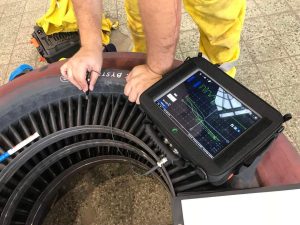
Sound emission (AT) test
The acoustic emission method belongs to non-destructive test methods (NDT). Acoustic emission testing, including requirements for measurement procedures, instrumentation and general methodology, shall be subject to generally applicable international standards. Thanks to its versatility, the method is used in a number of different fields (automotive, aerospace, gas and oil industry, chemical and electricity industry).
The principle of the acoustic emission method is based on the formation of a defect (initiation and subsequent propagation of the crack), during which there is a generation of elastic waves that propagate through the body and which can be captured by a specified network / raster of sensors. These waves are often referred to as "acoustic emission", although acoustics are not de facto as such. An important advantage of this method is that it is an integral, volumetric testing methodology, i.e. the entire volume of the examined body is tested in real time.
